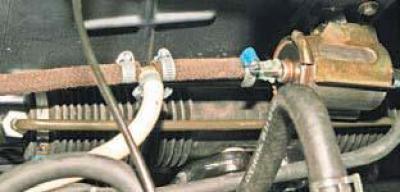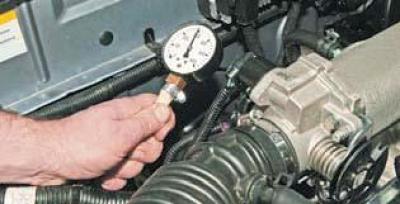To do this, you need a pressure gauge with a measurement range of 0-6 bar (e.g. from a tire pump), oil and petrol resistant hose (with inner diameter 8 mm), tee (with outer tube diameter 8 mm) and worm clamps (6 pcs.).
We work on a cold engine.
Relieve pressure in the engine power system (see Fuel filter replacement).
Remove the fuel pipe connecting the fuel filter and the fuel rail (see Fuel filter replacement and Removing the fuel rail and injectors).
We put a hose on the outlet fitting of the fuel filter and fix it with a clamp.
We put the other end of the hose on the inlet fitting of the fuel rail and fix it with a clamp.
In a convenient place, we cut the hose and install the tee, fixing the hoses on the fittings of the tee with clamps.

We put a piece of hose on the free fitting of the tee, on the other end of which we install a pressure gauge, and fix the hose with clamps.
We turn on the ignition and check the tightness in the connections of the installed device.
We start the engine and when it is idling..

... we measure the fuel pressure in the system, which should be equal to 2.8–3.3 bar.
After stopping the pump, the pressure may decrease slightly and then stabilize for a while.
If the pressure in the system is more than 3.3 bar, the fuel pressure regulator is faulty.
A low but stable fuel pressure in the fuel system can be caused by a clogged fuel filter or fuel module strainer, or a malfunctioning fuel pump or fuel pressure regulator.
To check the fuel filter for contamination, it must be removed (see Fuel filter replacement), drain the remaining fuel from the filter and blow through a piece of hose (you can mouth).
The resistance to the passage of air during purging should be negligible.
Otherwise, we replace the fuel filter with a new one, which we recommend always having in stock.
If the fuel pressure in the engine supply system is low and continues to drop after the pump is turned off, then the cause of this may be leaks in the fuel module connections, a pump malfunction, and leaks in the injectors.
To find the cause of the malfunction, turn on the fuel pump again and, after it stops, completely pinch the rubber hose in the area between the filter and the tee.
If at the same time the pressure stabilizes, then the fuel module is leaking or the pump is faulty.
If the pressure continues to drop, one or more injectors are leaking or the fuel pressure regulator is faulty.
A leaky injector can usually be identified by the dark color of its atomizer, which contains coked fuel droplets.
